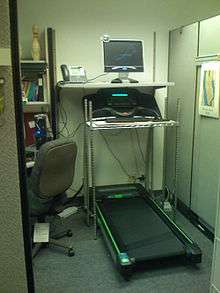Total Worker Health

Total Worker Health is a trademarked strategy integrating occupational safety and health protection with health promotion to prevent worker injury and illness to advance health and well-being. It was conceived and funded by the National Institute for Occupational Safety and Health (NIOSH). Total Worker Health is tested and developed in four "Centers of Excellence" in the United States.
History

Total Worker Health originated from the Steps to a Healthier US Workforce symposium in October 2004, which sought to bring together knowledge and experience of health protection and health promotion, in order to stimulate action for the development of programs.[1] The syposium developed around themes of research, practice and policy related to the integration of health protection and health promotion.[1]
By 2005, the initiative was redeveloped from the Steps to a Healthier US Workforce Symposium and renamed the NIOSH WorkLife Initiative.[1] The WorkLife Initiative supported addressing worker health and well-being in a novel way, by addressing the physical and organizational work environment concurrently with personal health decisions and behaviors of individuals.[1] Some aims of the WorkLife Initiative included supporting evaluation of integrative approaches to work and health, promoting adoption of proven policies and practices, motivating trans-disciplinary collaboration among investigators and overcoming the traditional separation of occupational health and health promotion among professional communities.[1] In September 2007, NIOSH and 35 other sponsors conducted the "WorkLife 2007: Protecting and Promoting Worker Health" symposium, in which over 450 participants explored the science and economics of integrated work-based programs, policies and practices that sustain and improve worker health and well-being.[1] Collaborators at the symposium, which included leaders from labor, business and academic communities provided evidence of work and health benefits from integrated approaches.[1] Coupled with case studies and anecdotal reports, the overall consensus was that such integrated work-based programs, if executed and sustained properly, can be good for worker health and business.[1]
In 2008, collaborators at NIOSH and the Centers of Excellence developed 10 recommendations, grouped in practice, research and policy, as a long-range strategy for advancing the WorkLife Initiative.[2] These recommendations were based on evidence-based practice and research-to-practice initiatives.[2] In 2011, a collaborative symposium with other federal agencies culminated in the "Healthier Federal Workers 2011 Symposium", which applied the integrated work health approaches to federal employees.[1]
In 2011, NIOSH WorkLife became "Total Worker Health" to better convey the more comprehensive approach to workplace prevention.[3] With Total Worker Health, NIOSH can continue to develop the initiatives from the WorkLife Initiative through research, interventions, partnerships and capacity building to meet the needs of the 21st-century workforce.[3] The 10th International Conference on Occupational Stress and Health, known as Work, Stress and Health 2013 will be organized by NIOSH along with the American Psychological Association and the Society for Occupational Health Psychology and will center on Total Worker Health.[4]
Proposed provisions to the Affordable Care Act for 2014 onwards, made by the Obama administration, include a proposed rule allowing employers to increase incentives awarded to employees participating in workplace wellness programs.[5][6] Specifically, employers will be able to increase incentives from the currently allowable 20% to as much as 30% of an employee's insurance costs, and up to 50% in some cases.[5] This provision applies to employees working towards achieving an agreed-upon wellness goal.
Centers of Excellence
NIOSH has funded four Centers of Excellence in the United States to explore and research concepts of Total Worker Health.[7] Some tasks of the Centers of Excellence include:[7]
- Pilot testing promising workplace policies and programs
- Developing and disseminating best practices and tool kits
- Developing strategies for overcoming barriers to organizational acceptance and adoption of comprehensive, coordinated work-based health protection and promotion interventions
- Investigating costs and benefits associated with integrated programs
- Promoting increased development and application of physiological and biological markers of stress, sleep, and depression and their use for worker protection or improved health outcomes
The four Centers of Excellence are based in four separate universities in the United States. Locations of said Centers are as follows:
- Center for the Promotion of Health in the New England Workplace - University of Massachusetts Lowell and University of Connecticut at Farmington and Storrs.
- Harvard School of Public Health Center for Work, Health and Wellbeing - Harvard School of Public Health - Boston, Massachusetts
- Oregon Healthy WorkForce Center - Oregon Institute of Occupational Health Sciences, Oregon Health & Science University - Portland, Oregon
- University of Iowa Healthier Workforce Center for Excellence - The University of Iowa - Iowa City, Iowa
Essential Elements of Effective Workplace Programs
From the collaborations with the WorkLife Initiative, the Essential Elements of Effective Workplace Programs and Policies for Improving Worker Health and Wellbeing were developed detailing 20 key components of a comprehensive work-based health protection and health promotion program.[8] These components were grouped into one of four areas: Organizational Culture and Leadership; Program Design; Program Implementation and Resources; and Program Evaluation.[8] The essential elements of effective workplace programs are as follows:
Organizational Culture and Leadership
- Develop a "human centered" culture
- Demonstrate leadership
- Engage mid-level management
Program Design
- Establish clear principles
- Integrate relevant systems
- Eliminate recognized occupational hazards
- Be consistent
- Promote employee participation
- Tailor programs to the specific workplace
- Consider incentives and rewards
- Find and use the right tools
- Adjust the program as needed
- Make sure the program lasts
- Ensure confidentiality
Program Implementation and Resources
- Be willing to start small and scale up
- Provide adequate resources
- Communicate strategically
- Build accountability
Program Evaluation
- Measure and analyze
- Learn from experience
Research
Sit-stand workstations

Concerns over the increasingly sedentary lifestyle of individuals and the associated health risks lead to this development. A study from a large sample of Australian adults found that prolonged sitting was a risk factor for all-cause mortality, independent of physical activity.[9] Sit-stand workstations are custom-built computer workstations, allowing the user to adjust the height of the workplace envelope and to work while standing. With the implementation of sit-stand workstations, individuals will be able to reduce sedentary time while at work, thereby improving health outcomes, and possibly improving work productivity.
Published research in 2012 on the benefits from implementing sit-stand workstations in the workplace has resulted in the development of some pilot studies for Total Worker Health. While the individual results of the studies varied, the researchers found that sit-stand workstations resulted in an overall improvement in health outcomes of workers who switched to these workstations, in addition to the reduced sitting time. Such health benefits from these pilot studies include increased HDL cholesterol, improved mood outcomes, reduced eye strain, and reduced upper back, neck and shoulder pain.[10][11][12] Robertson et al. found that the sit-stand workstation users, who were trained to vary their postures at work, exhibited increased productivity at work, compared to those who were not trained so.[12] Further, the study by Pronk et al. showed decreased fatigue and increased vigor among participants.[11] With these findings, NIOSH has begun a pilot program among employees for the Total Worker Health initiative.[13]
Health care workers
Several studies out of the Harvard Center for Work, Health and Wellbeing have focused on the relationships between work context and quality of life measures for health care workers. A survey of over 1500 hospital patient care workers examined the relationships between health outcomes (lower back pain, inadequate physical activity, and sleep deprivation) and work context measures.[14] Inadequate physical activity and sleep deficiency were associated, while lower back pain was not significantly related to either stressor.[14] Work context measures, such as low supervisor support, harassment at work, job title, and job culture were found to be associated with the quality of life and health outcomes for the hospital care workers.[14]
Aging workforce

Aging in the American workforce, the rapidly increasing numbers of older workers (ages 55 and above) comprising the workforce in the United States, could have significant impacts to the economy, social security benefits, occupational safety and health, health care, and American society as a whole. Researchers from the American College of Occupational and Environmental Medicine (ACOEM) and NIOSH convened a national Invitational Summit on ‘’Advancing Workplace Health Protection and Promotion in the Context of an Aging Workforce’’ to address several questions and to develop consensus statements and recommendations for a national approach to tackle these issues.[15] These issues included why employers should care about aging in the workplace, how to establish best practices to maximize health and productivity of aging workers, how organizational structures can better approach aging in the workplace, what are the barriers to integrating health protection and promotion programs for aging workers, and what tools, programs, and resources exist to overcome the barriers.[15] Some of the consensus statements conceived during this summit include creating a “culture of health” throughout the workplace, creating “age-friendly” programs and policies, increasing the use of incentives to impact change, integrating workforce health as a standard business measures, conducting new research and models to analyze data, and creating a new culture of “shared accountability.”[15]
Organizations with Successful Integrated Health, Safety and Productivity Management Programs
Various companies have implemented integrated health protection and health promotion management programs successfully, with documented health improvements and cost savings.[16] Each integrated program varies a bit in focus areas and in implementation, but follow the components of Total Worker Health. Examples of companies that have yiedled successful results from their programs include Caterpillar, FedEx, Dow Chemical and Perdue Farms.[16]
See also
- Health promotion
- Lifestyle management programme
- Occupational health psychology
- Occupational hygiene
- Occupational safety and health
- Participatory ergonomics
- Prevention through design
- Workplace health promotion
- Workplace wellness
External links
- NIOSH Topic Page for Total Worker Health
- Twitter Page for Total Worker Health
- Journal of Occupational and Environmental Medicine - December 2013 - Volume 55 Supplement
- 2012 Total Worker Health Symposium Presentation Content
- Total Worker Health Centers for Excellence
- Center for the Promotion of Health in the New England Workplace
- Harvard School of Public Health Center for Work, Health, and Well-being
- Oregon Health WorkForce Center
- Healthier Workforce Center for Excellence
- Official Home Page of Total Worker Health
References
- 1 2 3 4 5 6 7 8 9 "CDC - Total Worker Health History of Total Worker Health - NIOSH Workplace Safety and Health Program". NIOSH. Retrieved 23 October 2012.
- 1 2 Cherniack, Martin; Henning, Rob; Merchant, James A.; Punnett, Laura; Sorensen, Laura R.; Wagner, Gregory (2011). "Statement on National WorkLife Priorities". American Journal of Industrial Medicine. 54: 10–20. doi:10.1002/ajim.20900. Retrieved 23 October 2012.
- 1 2 "CDC - Total Worker Health WorkLife Transitions to Total Worker Health - NIOSH Workplace Safety and Health Program". NIOSH. Retrieved 23 October 2012.
- ↑ "Work, Stress and Health 2013". American Psychological Association. Retrieved 9 January 2013.
- 1 2 "CDC - NIOSH - Total Worker Health in Action - January 2013". NIOSH. Retrieved 31 January 2013.
- ↑ "Obama administration moves forward to implement health care law, ban discrimination against people with pre-existing conditions". HHS. Retrieved 31 January 2013.
- 1 2 "CDC - Total Worker Health WorkLife Centers of Excellence - NIOSH Workplace Safety and Health Program". NIOSH. Retrieved 11 October 2012.
- 1 2 "CDC - Total Worker Health Essential Elements of Effective Workplace Programs - NIOSH Workplace Safety and Health Program". NIOSH. Retrieved 23 October 2012.
- ↑ van der Ploeg, HP; Chey, T; Korda, RJ; Banks, E; Bauman, A (2012). "Sitting time and all-cause mortality in 222497 Australian adults". Arch Intern Med. 172 (6): 494–500. doi:10.1001/archinternmed.2011.2174. PMID 22450936.
- ↑ Alkhajah, TA; Reeves, MM; Eakin, EG; Winkler, EA; Owen, N; Healy, GN (2012). "Sit-stand workstations: a pilot intervention to reduce office sitting time". Am J Prev Med. 43 (3): 298–303. doi:10.1016/j.amepre.2012.05.027. PMID 22898123.
- 1 2 Pronk, NP; Katz, AS; Lowry, M; Payfer, JR (2012). "Reducing occupational sitting time and improving worker health: The Take-a-Stand Project, 2011". Prev Chronic Dis. 9 (110323). Retrieved 11 December 2012.
- 1 2 Robertson, MM; Ciriello, VM; Garabet, AM (2012). "Office ergonomics training and a sit-stand workstation: effects on musculoskeletal and visual symptoms and performance of office workers". Appl Ergon. 44 (1): 73–85. doi:10.1016/j.apergo.2012.05.001. PMID 22727324.
- ↑ "CDC - NIOSH Science Blog - NIOSH Takes a Stand". NIOSH. Retrieved 11 December 2012.
- 1 2 3 Sorensen, G; Stoddard, AM; Stoffel, S; Buxton, O; Sembajwe, G; Hashimoto, D; Dennerlein, JT; Hopcia, K (2011). "The Role of the Work Context in Multiple Wellness Outcomes for Hospital Patient Care Workers". JOEM. 53 (8): 899–910. doi:10.1097/JOM.0b013e318226a74a. PMID 21775897.
- 1 2 3 Loeppke, Ronald R.; Schill, Anita L.; Chosewood, L. Casey; Grosch, James W.; Allweiss, Pamela; Burton, Wayne T.; Barnes-Farrell, Janet L.; Goetzel, Ron Z.; Heinen, LuAnn; Hudson, T. Warner; Hymel, Pamela; Merchant, James; Edington, Dee W.; Konicki, Doris L.; Larson, Paul W. (2013). "Advancing Workplace Health Protection and Promotion for an Aging Workforce". Journal of Occupational and Environmental Medicine. 55 (5): 500–506. doi:10.1097/jom.0b013e31829613a4. PMID 23657074.
- 1 2 Goetzel, Ron Z. (2005). "Examining the Value of Integrating Occupational Health and Safety and Health Promotion Programs in the Workplace" (PDF). NIOSH Report. Retrieved 23 October 2012.